Qualcomm Snapdragon 805 Performance Preview
by Anand Lal Shimpi on May 21, 2014 8:00 PM EST- Posted in
- Tablets
- Snapdragon
- Qualcomm
- Mobile
- SoCs
- Snapdragon 805
CPU Performance
As always we'll start out our performance investigation with a handful of CPU bound web browser based tests. In all cases we used Chrome on the MDP/T. Remember there's only an 8% increase in peak CPU frequency here, so I wouldn't expect a huge difference vs. Snapdragon 801.
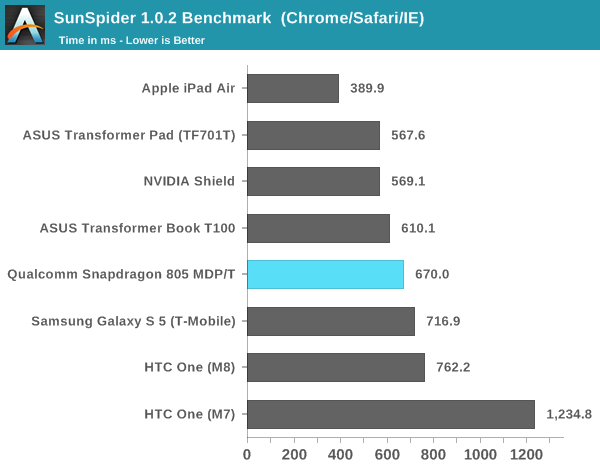
Here the MDP/T scales pretty well, showing a 6% improvement in performance over the Snapdragon 801 based Galaxy S 5. In the case of the GS5 we are looking at a 2.5GHz Snapdragon 801 implementation, so the improvement makes sense. Both the Cortex A15 (TF701T/Shield) and Apple's Cyclone (in the iPad Air) are higher performing designs here. Since there's no fundamental change to Krait's IPC, the only gains we see here are from the higher clock speed.
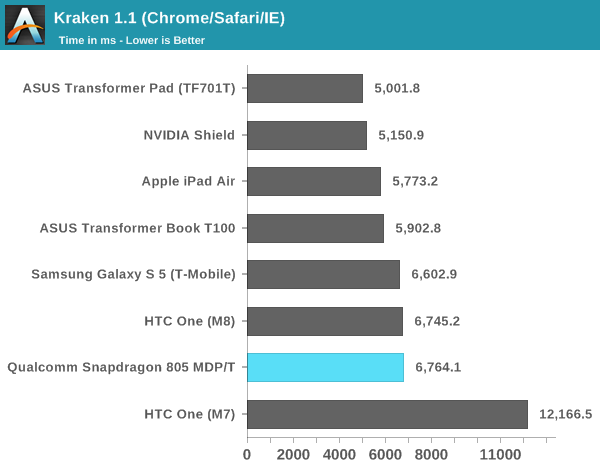
Kraken appears to be at its limit when it comes to Krait 400/450, there's effectively no additional frequency scaling beyond 2.3GHz. We're either running into an architectural limitation or limits of the software/browser combination itself.
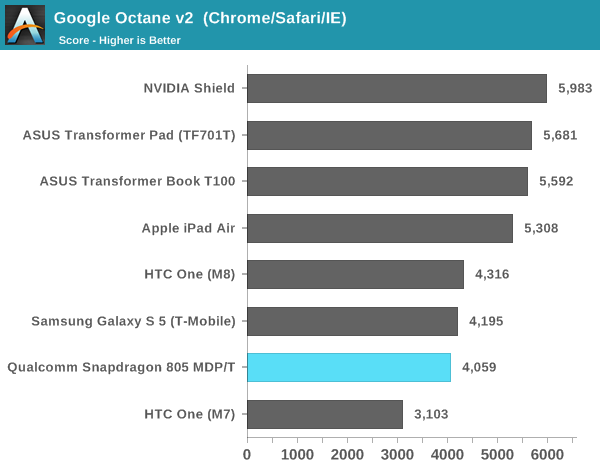
Similarly we don't see any real progress in the Google Octane test either. Snapdragon 805's CPU cores may run at a higher peak frequency but that's definitely not the story here.
Basemark OS II
Basemark OS II gives us a look at native application performance across a variety of metrics. There are tests that hit the CPU, GPU as well as storage subsystems here. The gains here are exclusively on the graphics side, which makes sense given what we've just seen. Snapdragon 805's biggest gains will be GPU facing.
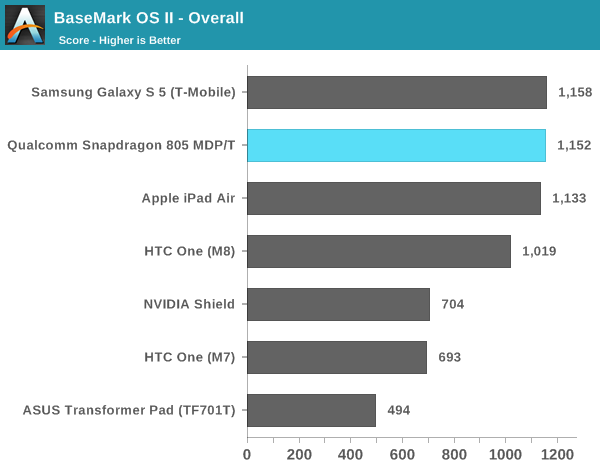
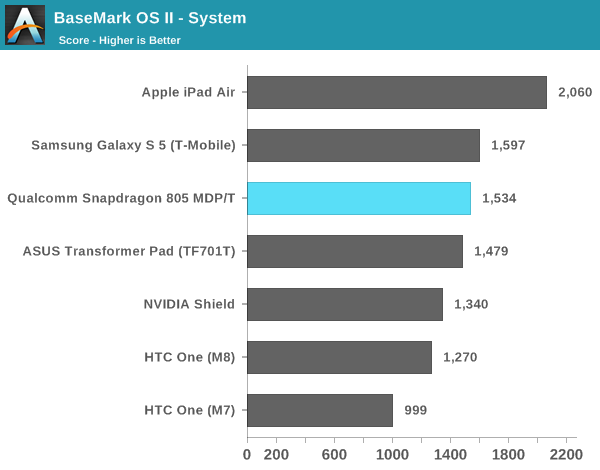


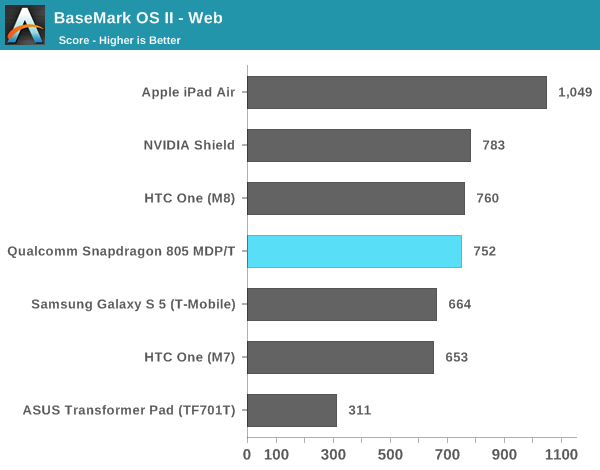
Geekbench 3.0
Although I don't typically use Geekbench, I wanted to include some numbers here to highlight that the increase in memory bandwidth for S805 over S801 doesn't really benefit the CPU cores:
| Geekbench 3.0 | |||||
| Snapdragon 801 2.3GHz (HTC M8) | Snapdragon 805 2.7GHz (MDP/T) | % Increase for S805 | |||
| Overall (Single thread) | 1001 | 1049 | 4.8% | ||
| Overall (Multi-threaded) | 2622 | 2878 | 9.7% | ||
| Integer (Single thread) | 956 | 996 | 4.2% | ||
| Integer (Multi-threaded) | 2999 | 3037 | 1.3% | ||
| FP (Single thread) | 843 | 925 | 9.7% | ||
| FP (Multi-threaded) | 2636 | 3155 | 19.7% | ||
| Memory (Single thread) | 1411 | 1406 | 0% | ||
| Memory (Multi-threaded) | 1841 | 1949 | 6% | ||
I wouldn't read too much into the multithreaded FP results, I suspect we're mostly seeing differences in thermal dissipation of the two test units. A closer look at the memory bandwidth numbers confirms that while the 805 has more memory bandwidth, most of it is reserved for GPU use:
| Geekbench 3.0 - Memory Bandwidth | |||||
| Snapdragon 801 2.3GHz (HTC M8) | Snapdragon 805 2.7GHz (MDP/T) | % Increase for S805 | |||
| Stream Copy (Single thread) | 7.89 GB/s | 8.04 GB/s | 1.9% | ||
| Stream Copy (Multi-threaded) | 9.53 GB/s | 10.1 GB/s | 5.9% | ||
| Stream Scale (Single thread) | 5.36 GB/s | 5.06 GB/s | - | ||
| Stream Scale (Multi-threaded) | 7.31 GB/s | 7.63 GB/s | 4.3% | ||
| Stream Add (Single thread) | 5.27 GB/s | 5.2 GB/s | - | ||
| Stream Add (Multi-threaded) | 6.84 GB/s | 7.51 GB/s | 9.8% | ||
| Stream Triad (Single thread) | 5.64 GB/s | 5.85 GB/s | 3.7% | ||
| Stream Triad (Multi-threaded) | 7.65 GB/s | 7.89 GB/s | 3.1% | ||










149 Comments
View All Comments
ams23 - Thursday, May 22, 2014 - link
You just don't get it. Tegra is focused on automotive, embedded, consumer, and gaming products. Mainstream smartphones is NOT a focus now. Tegra will make it's way into some high end differentiated smartphone products in the future, but the lion's share outside of Apple and Samsung will go to Qualcomm and Mediatek. Qualcomm is able to attractively bundle their modem with their SoC, and certain large carriers have legacy WCDMA networks that require Qualcomm's modem tech. Mediatek is the lowest cost provider. That's life, and it takes nothing away from Tegra K1 which is still a revolutionary product for the ultra mobile space.fteoath64 - Saturday, May 24, 2014 - link
QC's lead in mobile chips and their pricing probably account for the leading position until MediaTek and others starts chipping away on prices and performance. The failure of Tegra3 shows where the price/performance point was and Nvidia knows that and it is the reason why they venture to automotive and other products becuase these needed powerful and higher power gpu chips as opposed to mobile. Except for rendering video in 10bit, and possibly 120fps video encode, there is no real need for the 805 in a phone. The S5 shows that the 801 is more than capable of all things mobile yet have an acceptable battery life. The K1 is a beast in itself being able to do vision graphics and VR stuff. Not that the 805 cannot do but probably better at it in a competitive price package. Nvidia Icera 500 modem is not as popular either having gone through the certification of carriers yet is hardly in any handsets commercially. Also Nvidia knows this up front.Alexey291 - Tuesday, May 27, 2014 - link
what's the focus then? Testbed devices? It can be as "revolutionary" as you claim (or more likely its just a downclocked desktop part)And what sort of a revolution will a device with no OEM wins will cause? I mean we know there are faster parts in the hardware market as a whole. We also know that some of them used 250watts of power. So why does a part with high power usage and higher performance surprise anyone? :)
Ghost0420 - Wednesday, May 28, 2014 - link
It was NV's 1st LTE integration attempt. Carrier Qualification takes long, and since it's the 1st NV silicon with integrated LTE, it probably took longer. If NV, can continue to develop it's LTE, and not have any IP issues with QC, i'm sure NV would give QC a run for their $$. think of it this way, QC been in the game for awhile...NV showed up about 5yrs ago, was able to give enough competition for TI to leave the phone market. (NOT saying NV should take credit for this). and now with K1 GPUhahmed330 - Friday, May 23, 2014 - link
Tegra 2 & 3 were both subsidised. Tegra 4 isn't and it was delayed as well thats why there were fewer design wins. Also the fact that it didn't had integrated. Not because it lowers power required. Integration of LTE modem doesn't lowers power consumption. (apple's iphone 5s doesn't have integrated modem) Integration of modem reduces oem costs instead.Ghost0420 - Wednesday, May 28, 2014 - link
More than likely, QC has a strangle hold on LTE, as they're not likely to license out their tech to a competitor. they've been in the Phone game longer, so OEMs probably have it easier on the Sftwre side. QC SD SoCs run hot too, just as hot as any other SoC. I've had Tegra devices and SD devices, both run at similar temp to the touch. except the T4 devices don't lag as much as SD devices (This could be due to stupid TouchWiz)Flunk - Thursday, May 22, 2014 - link
If they don't get the actual production hardware out there, it doesn't mean much.ArthurG - Thursday, May 22, 2014 - link
For you:http://en.miui.com/thread-22041-1-1.html
5hours heavy 3D game on 6700mAH battery means that TK1 runs with ~3W
and 11 hours on video
so excellent numbers when taking into account performance
testbug00 - Thursday, May 22, 2014 - link
The GPU is running in the mid-600 Mhz range (from the 950Mhz or so Nvidia touted) and the CPU is certainly also downclocked.Do you have performance numbers for that game? How about how fast/power usage on competitor chips? Not enough knowledge to draw large conclusions... Still, really odd how NVidia is not talking about the clockspeeds in the tablet... You think they would talk up how highly clocked and efficient their chip is...
kron123456789 - Thursday, May 22, 2014 - link
"The GPU is running in the mid-600 Mhz range" — How do you know that? Where is proof?